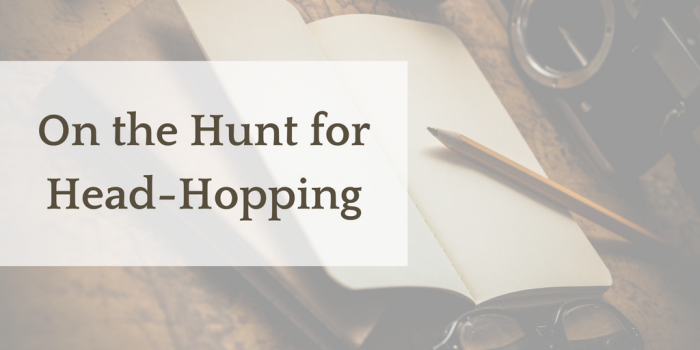Have you ever tried on a pair of unfamiliar glasses? If so, then you know the disorientation that follows as your eyes scramble to adjust and the world won’t come into focus. Now imagine you’re reading, content in the mind and viewpoint of one character, when suddenly you’re seeing through the eyes of another. Similar to trying on the glasses, this shift is uncomfortable, distracting, and displaces you, the reader. This is head-hopping, an issue you, the writer, want to avoid.
Head-hopping refers to an abrupt shift of point of view in the middle of a sentence, paragraph, or scene. Head-hopping is not to be confused with point of view switches that are preempted—such as with scene or chapter change indicators—which can prove an effective tool. Head-hopping yanks readers without warning from one head and drops them into another. It pulls the plug on pacing and isn’t conducive to a relaxed and submersive reading experience.
Take, for example, the following scene:
Jennifer leaned into the heat of the window pane, watching the small rabbit digging up her mother’s garden. It was a beautiful evening, a quiet evening, and she could almost ignore the pit in her stomach warning of her mother’s return. The hand on her lap was clenched in fear, and he knew why, even if he pretended not to. Alec didn’t want to pick a side. He offered her a can of seltzer as he passed by; she reached for it, wondering how many rabbits were hidden amongst the greens, but her fingers closed on air. The can hit the floor and rolled away.
The unexpected shifts from Jennifer’s point of view to Alec’s and then back to Jennifer’s are both jarring and confusing. Here are three ways to revise moments that head-hop:
1. Stick to a single character’s point of view. In this instance, we’ll say Jennifer. Allowing Jennifer’s perspective to carry the scene from beginning to end tightens the focus and doesn’t necessarily mean you’ll lose Alec’s thoughts; they’ll just be presented differently.
Jennifer leaned into the heat of the window pane, watching the small rabbit digging up her mother’s garden. It was a beautiful evening, a quiet evening, and she could almost ignore the pit in her stomach warning of her mother’s return. The hand on her lap clenched in fear. She heard Alec approach, and she wondered how much he knew, if anything; he’d never given any sign if he did. Out of the corner of her eye, saw a can of seltzer in his outstretched hand. She reached for it, wondering how many rabbits were hidden amongst the greens, but her fingers closed on air. The can hit the floor and rolled away.
2. Warn of a point of view switch by having one character exit or enter the room. This way the transition is expected, and readers will make the mental shift with ease. This also enables for a shorter submersion in another character’s thoughts without dedicating an entire chapter to each character’s point of view (see example 3). Remember: if you do choose this option, don’t jump too swiftly back to Jennifer’s point of view. If you’re going to switch, readers must live in that character’s perspective for longer than a paragraph, and there must be an equally smooth transition back to Jennifer’s.
Jennifer leaned into the heat of the window pane, watching the small rabbit digging up her mother’s garden. It was a beautiful evening, a quiet evening, and she could almost ignore the pit in her stomach warning of her mother’s return.
The floor squeaked as Alec jogged into the kitchen and yanked open the fridge. He grabbed a seltzer and glanced at his sister, perched on the kitchen window seat. The hand on her lap was clenched in fear, and he knew why, even if he pretended not to. Alec didn’t want to pick a side, knowing if he did, it would only make things worse. He grabbed another seltzer, and offered it to her on his way out. What was she looking at? He bent towards her, looking over her head and out into the garden, and the can slipped free.
3. Allot alternating chapters to Alec and Jennifer. Think Barbara Kingsolver’s The Poisonwood Bible and Junot Díaz’s The Brief Wondrous Life of Oscar Wao. Writing from multiple points of view will allow you to expand on each character’s thoughts and emotions, and can be a wonderful device for providing context and maintaining urgency.
Regardless of the direction you choose, think carefully about why you hopped heads in the first place. What does the other character bring to the scene that made you include them? Write the scene from each character’s point of view, and then decide which works best!

